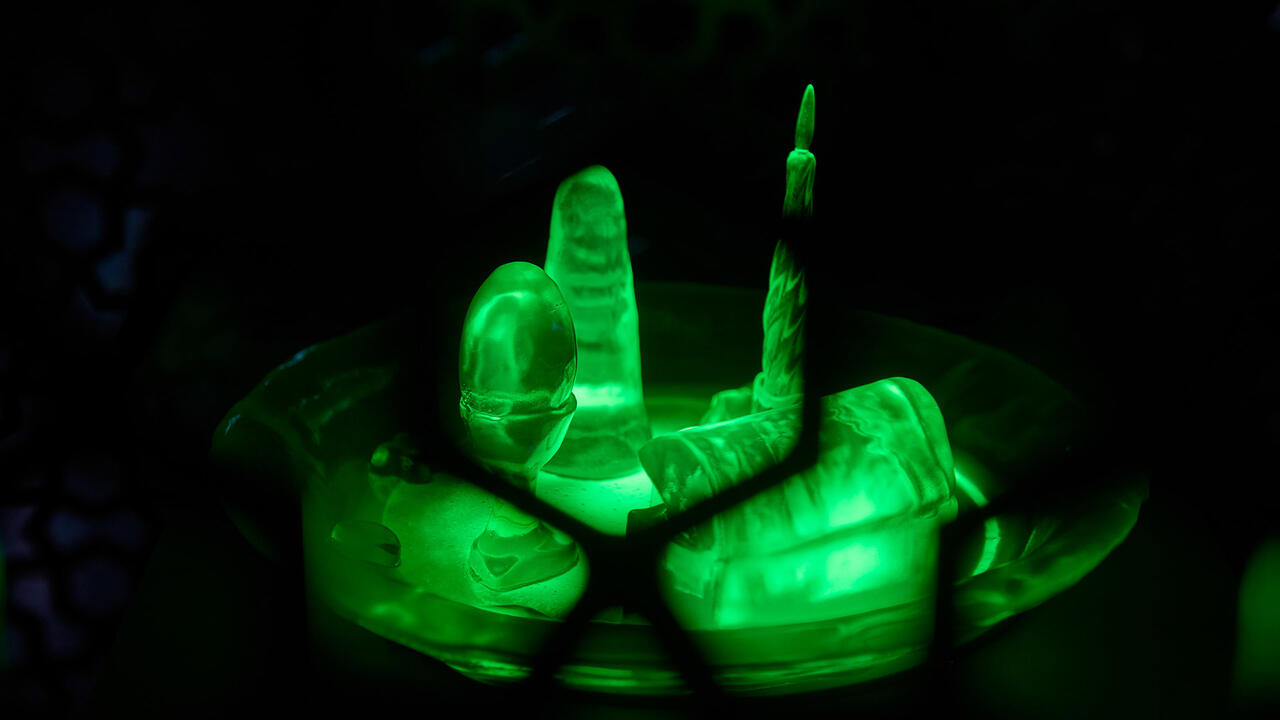‘Interflow’ Buries Climate Politics in Abstraction
A group show at Pilar Corrias, London, unites work dealing with the natural world and humanity’s impact on it
A group show at Pilar Corrias, London, unites work dealing with the natural world and humanity’s impact on it

‘Interflow’ is a tale of three parts: the works in the exhibition comprise chapters in a narrative that leads us from undefined entities through alchemical transformations to concrete forms. Each of the nine featured artists explores the building blocks of our world and, while overt depictions of the body are absent, the human will to construct and intervene is omnipresent.

The show opens with Peppi Bottrop’s Dotv (2022–23), a large canvas with expressive black and copper lashings in acrylic paint, charcoal and graphite. Its marks suggest unseen biological structures, perhaps underground networks of tangled roots or microneural pathways in the brain. Bottrop invites us to lose ourselves in its abstraction. Opposite, Jeff Wall’s photograph Trap set (2021) captures a wild tangle of thin branches and a murky woodland stream located in Vancouver, where the artist lives. An animal trap camouflaged by greenery is a small signifier of human interference in the landscape. However, Wall’s image implies that the natural world is too unruly to fully contain.

The jagged branches engulfing Wall’s image mirror the expressive marks in Joan Snyder’s multimedia work on linen, All Over (2022). Snyder covered the painting in papier-mâché elements and real rosebuds, evoking an ariel view of a pond with flotsam on its surface – a macro perspective on biological matter or the formless freedom of abstraction.
Towards the middle of the gallery, the checkerboard floor tiles transition into wooden herringbone and the walls narrow. Here, the works focus on material transformation: Rachel Rose’s compact rock and glass sculpture Fifteenth Born (2019) comprises the same material in different forms, forged across vastly different time scales. Its transformational egg shape conveys the development and sustenance of new life in two parts, one cocooning the other.

Illusions to alchemical transformations pervade this section: Hanako Murakami’s Untitled (Iris #3) (2020) – an abstract work created by chemically manipulating vintage paper – evokes the outlines of hills. In another work by Rose, A mountainous landscape (2022), the artist has worked pools of coloured pigment into a digital scan of Joachim Patinir’s Landscape with Saint Jerome (1516–17). Mary Ramsden’s Small Feelings (2023) – an oil-on-canvas abstraction comprised of blue, green and black blocks – conjures the demarcated rectangles of agricultural landscapes viewed from above. After the early explosive chaos, these works suggest a world beginning to be shaped by the human hand.

The show’s final work is in the gallery’s back room. Entered through an arch, the effect is chapel-like, with natural light streaming from a glass roof onto Lubna Chowdhary’s ceramic and sapele wood sculpture, Serial Structures (2023), framed within the curved moulding of the back wall. Here, material is fully formed. Serial Structures is a wooden frame covered in 84 ceramic models of all shapes and colours, a hybrid celebration of design from modernism to Islamic geometric patterning. Serial Structures challenges our sense of scale: it could be a cityscape, a single architectural element or a microbiological form. Chowdhary seems to relish the alchemy of her mottled, bubbled, metallic and smooth glazes.

While our mark on the natural world is suggested throughout the exhibition, ‘Interflow’ avoids overt political statements about the impact of humans on the environment. Instead, the show presents manufactured forms in all their complexity and beauty. ‘Interflow’ leaves space for the viewer to both marvel at and fear our metamorphic power, our capacity for tremendous creativity and reckless devastation.
‘Interflow’ is at Pilar Corrias, London, until September 16
Main image: 'Interflow', 2023, exhibition view, Pilar Corrias, London. Courtesy: the artists and Pilar Corrias; photograph: Agnese / Eva Herzog Studio.






















